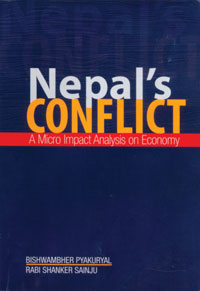|
|
The books that have come out since the ceasefire last year have all concentrated on the politically interesting period in Nepal's history. But few authors have assessed the socio-economic impact of the armed conflict and recommend strategies for reconstruction.
In Nepal's Conflict: A Micro-Impact Analysis on Economy, Bishwambher Pyakuryal, the economist and professor, and Rabi Shanker Sainju, program director at the National Planning Commission, fill this gap.
Aside from the loss of life, the country was beset by population displacement and political instability. The authors conclude that the impact of the conflict on the country's economic growth has been much more serious than we previously imagined.
Nepal's economy grew at 4.8 percent in 1995-96, but growth had plummeted to minus 0.3 percent in 2001-02. Even after the ceasefire last year, the economy has only bounced back by 2.5 percent. The authors zoom in on the impact of the conflict on Small and Medium Enterprises (SMEs) in Banke, Rupandehi, Kaski, and Sunsari districts as case studies and extrapolate their observations there to the entire economy.
SMEs are the largest employers in the non-manufacturing sector and have brought in 40 percent of all industrial investment in the country. Industries with fixed assets of not more than Rs 30 million are designated small while those with up to Rs 100 million are medium industries.
The share of SMEs, including micro, cottage and small industries, in the total industrial output is 70 percent. Similarly, the shares of SMEs in total industrial establishment and total industrial employment are 96 percent and 83 percent respectively.
The study (conducted between July-September 2006) found that the flow of Chinese products in local markets has had a strong impact on these manufacturers. For example, one plastic sandal factory in Rupandehi that could not compete with Chinese sandals had to close down.
The study points out that the overall problem being faced by the SMEs is related to production and market failures. The conflict destroyed not only physical infrastructure, but also human capital and tore apart the social fabric. This is likely to create instability in the short-run and lower growth in the medium-term, the authors say.
More ominously, the conflict destroyed business linkages and distribution channels of SMEs in previous market areas. Although after the ceasefire raw material availability was not a problem, the cost of raw materials and logistics increased significantly.
The authors warn that a post-conflict period is very sensitive to economic policies and will respond to them. So an over-emphasis on political reforms, elections and party politics eclipsing necessary socioeconomic policies may backfire on overall reform initiatives.
The book lays out projections for various development scenarios under the state of continued conflict and under peaceful conditions from 2005-06 to 2017-21. It makes recommendations to revive economy and generate employment in general and support the SMEs to grow, in particular.
A recent annual report published by the International Development Department of the University of Birmingham says that conflict and security are critical issues for the development community. "By destroying economies, infrastructure, and societies, conflicts' impacts resonate long after the combatants have laid down their weapons," the report says.
Pyakyural and Sainju's book is a must read for students of Nepali politics as well as policymakers, and a timely warning not to sideline economics. Whoever is in power after the elections will have to address economic issues, otherwise stagnant production, and lack of job creation will continue to haunt politics for decades to come.
Bhagirath Yogi is a journalist with the BBC Nepali Service in London.
 Nepal's Conflict: A Micro-Impact Analysis on Economy
Nepal's Conflict: A Micro-Impact Analysis on Economy
Bishwambher Pyakuryal, Rabi Shanker Sainju
2007,
pp 120,
Rs 350



